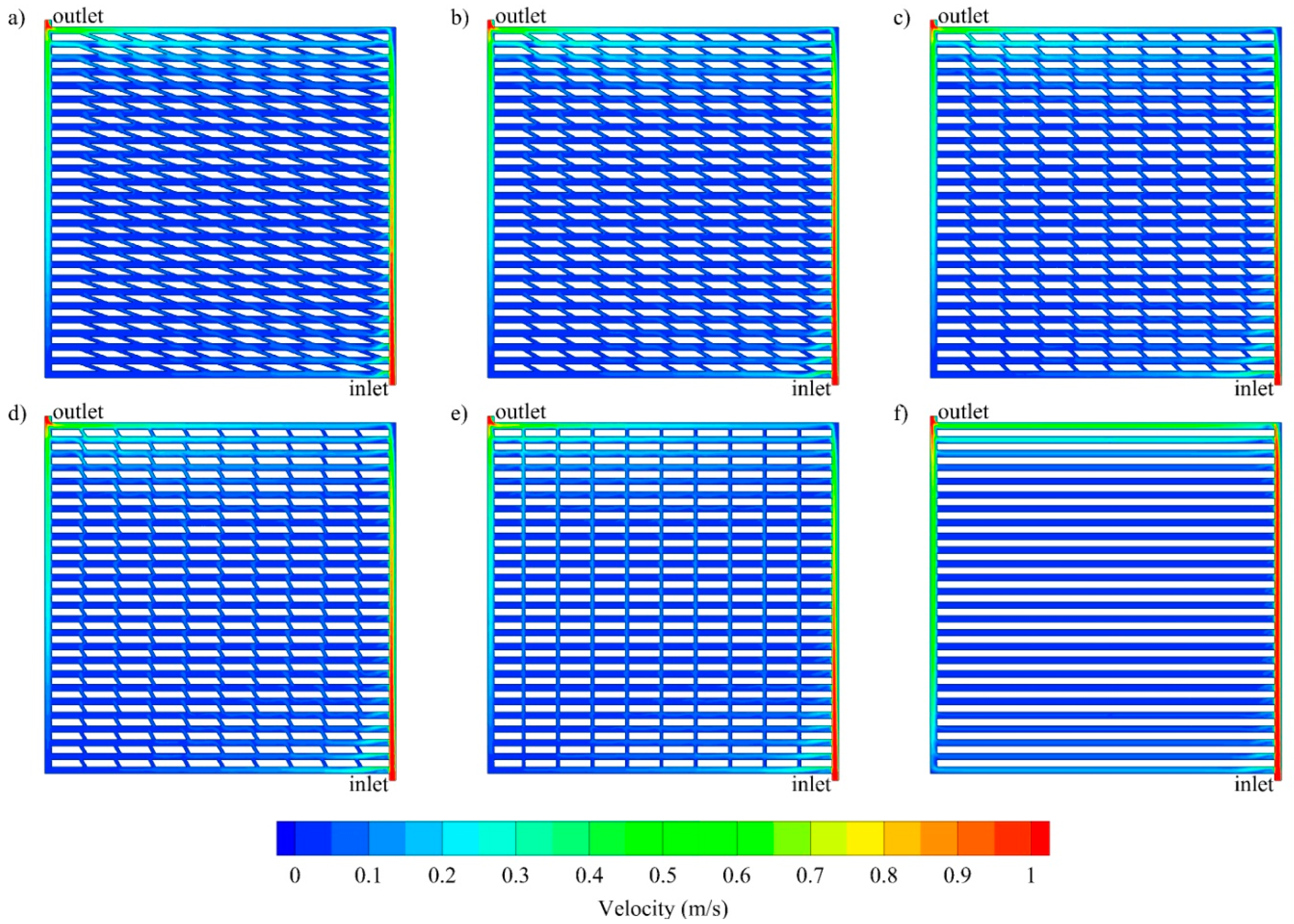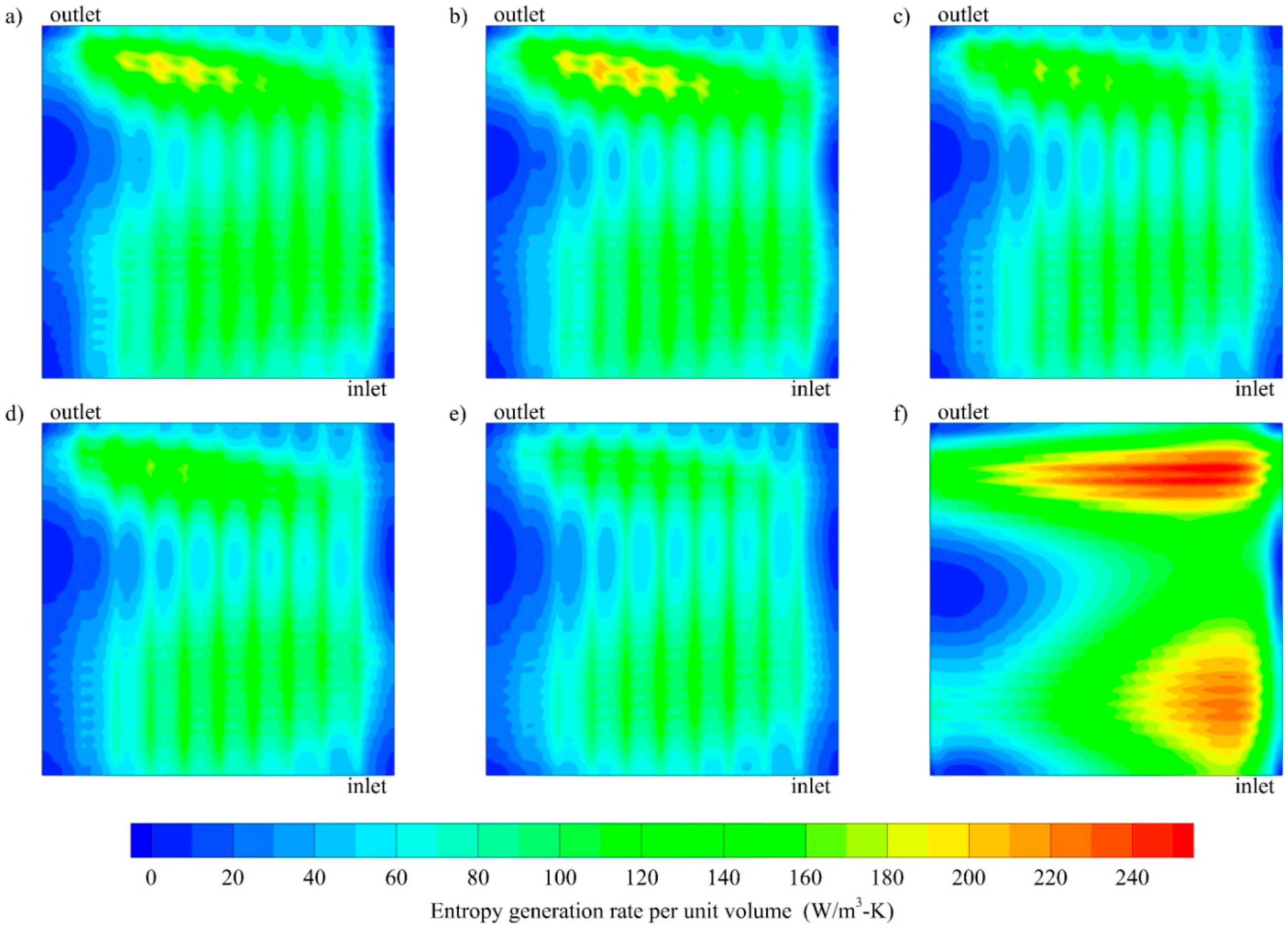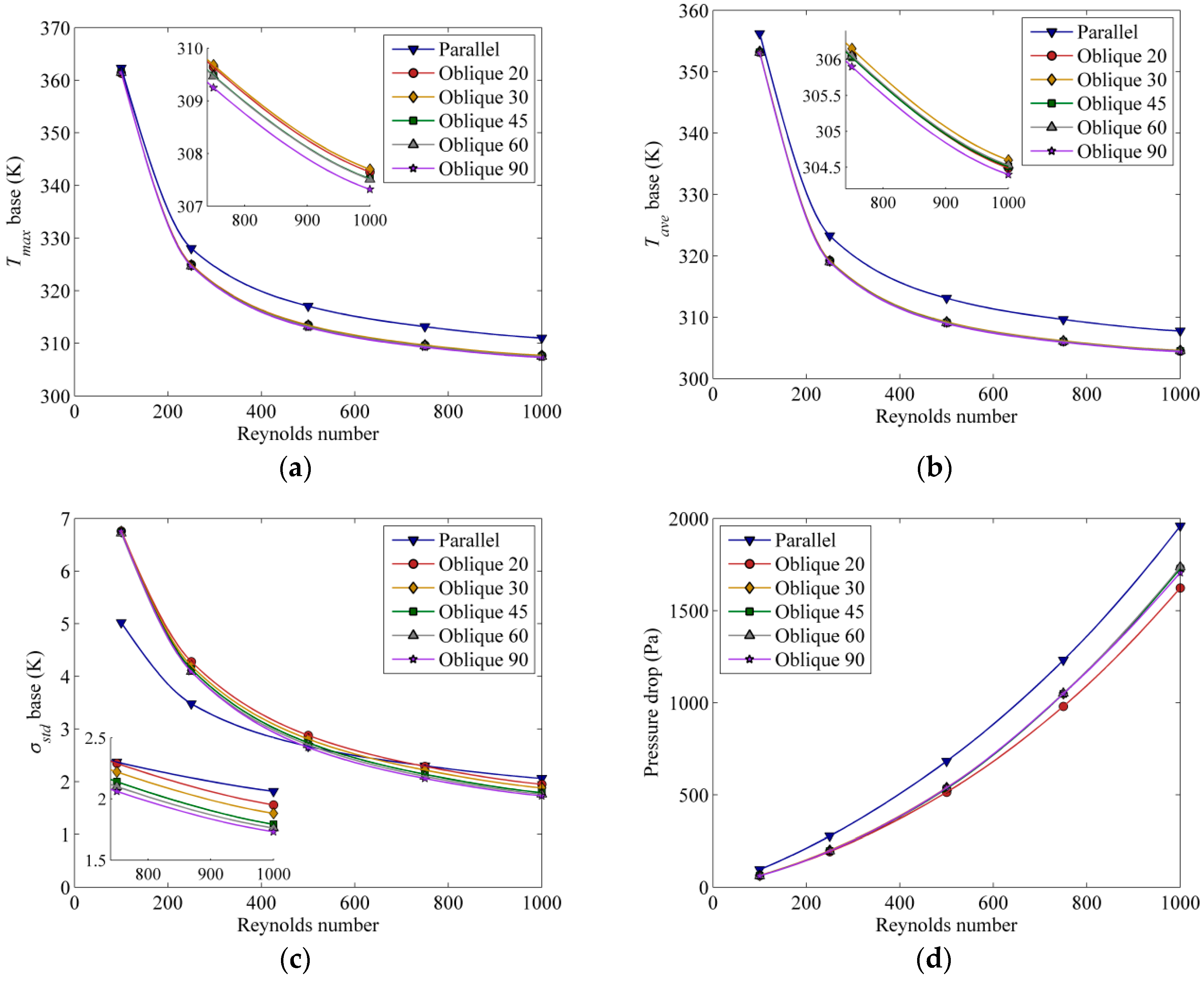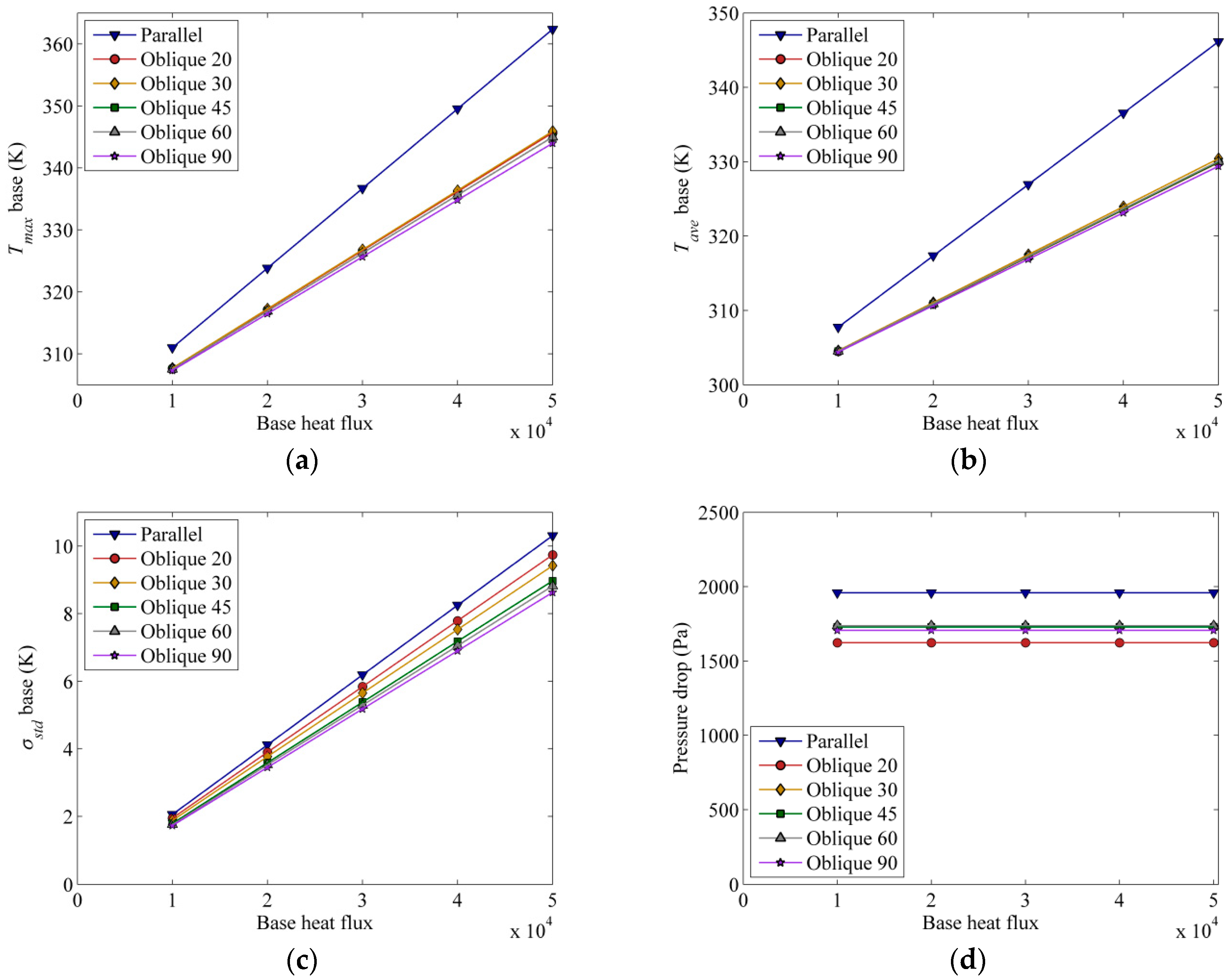Entropy Generation and Heat Transfer Performance in Microchannel Cooling
Abstract
:1. Introduction
2. Mathematical Model
2.1. Governing Equations
2.2. Constitutive Relations
2.3. Boundary Condition
2.4. Numerical Methodology
3. Results and Discussion
3.1. Model Validation
3.2. Effect of Channel Geometry
3.3. Effect of Mass Flow Rate
3.4. Effect of Base Heat Flux
3.5. Overall Heat Transfer Performance
4. Conclusions
Author Contributions
Funding
Acknowledgments
Conflicts of Interest
References
- Kurnia, J.C.; Sasmito, A.P.; Mujumdar, A.S. Numerical investigation of laminar heat transfer performance of various cooling channel designs. Appl. Therm. Eng. 2011, 31, 1293–1304. [Google Scholar] [CrossRef]
- Wang, H.; Chen, Z.; Gao, J. Influence of geometric parameters on flow and heat transfer performance of micro-channel heat sinks. Appl. Therm. Eng. 2016, 107, 870–879. [Google Scholar] [CrossRef]
- Yang, D.; Wang, Y.; Ding, G.; Jin, Z.; Zhao, J.; Wang, G. Numerical and experimental analysis of cooling performance of single-phase array microchannel heat sinks with different pin-fin configurations. Appl. Therm. Eng. 2017, 112, 1547–1556. [Google Scholar] [CrossRef]
- Zhao, J.; Huang, S.; Gong, L.; Huang, Z. Numerical study and optimizing on micro square pin-fin heat sink for electronic cooling. Appl. Therm. Eng. 2016, 93, 1347–1359. [Google Scholar] [CrossRef]
- Al-Neama, A.F.; Khatir, Z.; Kapur, N.; Summers, J.; Thompson, H.M. An experimental and numerical investigation of chevron fin structures in serpentine minichannel heat sinks. Int. J. Heat Mass Transf. 2018, 120, 1213–1228. [Google Scholar] [CrossRef]
- Ghani, I.A.; Sidik, N.A.C.; Kamaruzaman, N. Hydrothermal performance of microchannel heat sink: The effect of channel design. Int. J. Heat Mass Transf. 2017, 107, 21–44. [Google Scholar] [CrossRef]
- Lee, Y.J.; Singh, P.K.; Lee, P.S. Fluid flow and heat transfer investigations on enhanced microchannel heat sink using oblique fins with parametric study. Int. J. Heat Mass Transf. 2015, 81, 325–336. [Google Scholar] [CrossRef]
- Mou, N.; Lee, P.S.; Khan, S.A. Coupled equivalent circuit models for fluid flow and heat transfer in large connected microchannel networks—The case of oblique fin heat exchangers. Int. J. Heat Mass Transf. 2016, 102, 1056–1072. [Google Scholar] [CrossRef]
- Vinoth, R.; Senthil Kumar, D. Channel cross section effect on heat transfer performance of oblique finned microchannel heat sink. Int. Commun. Heat Mass Transf. 2017, 87, 270–276. [Google Scholar] [CrossRef]
- Prajapati, Y.K.; Pathak, M.; Khan, M.K. Transient heat transfer characteristics of segmented finned microchannels. Exp. Therm. Fluid Sci. 2016, 79, 134–142. [Google Scholar] [CrossRef]
- Ghani, I.A.; Sidik, N.A.C.; Mamat, R.; Najafi, G.; Ken, T.L.; Asako, Y.; Japar, W.M.A.A. Heat transfer enhancement in microchannel heat sink using hybrid technique of ribs and secondary channels. Int. J. Heat Mass Transf. 2017, 114, 640–655. [Google Scholar] [CrossRef]
- Om, N.I.; Zulkifli, R.; Gunnasegaran, P. Influence of the oblique fin arrangement on the fluid flow and thermal performance of liquid cold plate. Case Stud. Therm. Eng. 2018, 12, 717–727. [Google Scholar] [CrossRef]
- Sciacovelli, A.; Verda, V.; Sciubba, E. Entropy generation analysis as a design tool—A review. Renew. Sustain. Energy Rev. 2015, 43, 1167–1181. [Google Scholar] [CrossRef]
- Maskaniyan, M.; Nazari, M.; Rashidi, S.; Mahian, O. Natural convection and entropy generation analysis inside a channel with a porous plate mounted as a cooling system. Therm. Sci. Eng. Prog. 2018, 6, 186–193. [Google Scholar] [CrossRef]
- Mahmoodi, M.; Kandelousi, S. Analysis of the hydrothermal behavior and entropy generation in a regenerative cooling channel considering thermal radiation. Nucl. Eng. Des. 2015, 291, 277–286. [Google Scholar] [CrossRef]
- Khan, N.S.; Shah, Z.; Islam, S.; Khan, I.; Alkanhal, T.A.; Tlili, I. Entropy Generation in MHD Mixed Convection Non-Newtonian Second-Grade Nanoliquid Thin Film Flow through a Porous Medium with Chemical Reaction and Stratification. Entropy 2019, 21, 139. [Google Scholar] [CrossRef]
- Ries, F.; Li, Y.; Nishad, K.; Janicka, J.; Sadiki, A. Entropy Generation Analysis and Thermodynamic Optimization of Jet Impingement Cooling Using Large Eddy Simulation. Entropy 2019, 21, 129. [Google Scholar] [CrossRef]
- Al-Kouz, W.; Al-Muhtady, A.; Owhaib, W.; Al-Dahidi, S.; Hader, M.; Abu-Alghanam, R. Entropy Generation Optimization for Rarified Nanofluid Flows in a Square Cavity with Two Fins at the Hot Wall. Entropy 2019, 21, 103. [Google Scholar] [CrossRef]
- Silva-Llanca, L.; del Valle, M.; Ortega, A.; Díaz, A.J. Cooling Effectiveness of a Data Center Room under Overhead Airflow via Entropy Generation Assessment in Transient Scenarios. Entropy 2019, 21, 98. [Google Scholar] [CrossRef]
- Naterer, G.F.; Camberos, J.A. Entropy Based Design and Analysis of Fluids Engineering Systems; CRC Press: Boca Raton, FL, USA, 2008; ISBN 978-1-4200-0691-9. [Google Scholar]
- Kurnia, J.C.; Sasmito, A.P.; Shamim, T.; Mujumdar, A.S. Numerical investigation of heat transfer and entropy generation of laminar flow in helical tubes with various cross sections. Appl. Therm. Eng. 2016, 102, 849–860. [Google Scholar] [CrossRef]
- Kurnia, J.C.; Sasmito, A.P. Heat transfer performance and entropy generation of helical square tubes with various curvature radiuses. Energy Procedia 2017, 142, 4064–4069. [Google Scholar] [CrossRef]
- Kurnia, J.C.; Sasmito, A.P. Numerical Evaluation of Heat Transfer and Entropy Generation of Helical Tubes with Various Cross-sections under Constant Heat Flux Condition. MATEC Web Conf. 2018, 225, 03017. [Google Scholar] [CrossRef]








| Parameter | Symbol | Value | Unit |
|---|---|---|---|
| Base (heated wall) width | wbase | 5.10 × 10−2 | m |
| Channel width | wch | 1.00 × 10−3 | m |
| Channel height | hch | 1.00 × 10−3 | m |
| Separator height | hs | 1.00 × 10−3 | m |
| Oblique fin angle | θoblique | 20, 30, 45, 60 and 90 | degree |
| Oblique fin width | woblique | 5.00 × 10−4 | m |
| Oblique fin pitch | poblique | 5.00 × 10−2 | m |
| Total length of the channel | Lch | 1.376 | m |
| Inlet mass flow rate | 1.00 × 10−4 (Re 100), 2.50 × 10−4 (Re 250), 5.00 × 10−4 (Re 500), 7.50 × 10−4 (Re 750), 1.00 × 10−3 (Re 1000) | kg/s | |
| Outlet Pressure | Pout | 101,325 (1 atm) | Pa |
| Inlet temperature | Tin | 298.15 | K |
| Thermal conductivity of solid separator | ks | 387.6 | W/m2·K |
| Density of cooling fluid | ρw | 998.2 | kg/m3 |
| Viscosity of cooling fluid | μw | 10.03 × 10−3 | Pa·s |
| Thermal conductivity of cooling fluid | kw | 0.6 | W/m2·K |
| Specific heat capacity of cooling fluid | cp,w | 4182 | W/kg·K |
| Solid separator base heat flux | 10,000 (base case), 20,000, 30,000, 40,000 and 50,000 | W/m2 |
| Inlet Reynolds Number | 100 | 250 | 500 | 750 | 1000 |
|---|---|---|---|---|---|
| Analytical solution (K) | 360.16 | 322.95 | 310.55 | 307.01 | 304.35 |
| Present simulation (K) | 359.90 | 322.24 | 310.20 | 305.98 | 303.78 |
| Deviation (K) | 0.26 | 0.71 | 0.35 | 1.03 | 0.57 |
| Geometry | Inlet Reynolds Number | ||||
| 100 | 250 | 500 | 750 | 1000 | |
| Parallel | 1898.28 | 261.63 | 53.09 | 21.03 | 9.25 |
| Oblique 20 | 2873.38 | 376.02 | 70.49 | 26.41 | 11.16 |
| Oblique 30 | 2828.31 | 362.70 | 67.31 | 24.67 | 10.44 |
| Oblique 45 | 2907.87 | 369.46 | 67.96 | 24.71 | 10.49 |
| Oblique 60 | 2934.62 | 369.57 | 67.50 | 24.63 | 10.43 |
| Oblique 90 | 2924.93 | 368.80 | 67.47 | 24.69 | 10.62 |
| Base Heat flux (W/m2) | |||||
| 10,000 | 20,000 | 30,000 | 40,000 | 50,000 | |
| Parallel | 9.25 | 18.50 | 27.75 | 37.00 | 46.48 |
| Oblique 20 | 11.16 | 22.33 | 33.49 | 44.65 | 56.08 |
| Oblique 30 | 10.44 | 20.88 | 31.33 | 41.77 | 52.46 |
| Oblique 45 | 10.49 | 20.97 | 31.46 | 41.94 | 52.68 |
| Oblique 60 | 10.43 | 20.87 | 31.30 | 41.73 | 52.42 |
| Oblique 90 | 10.62 | 21.24 | 31.86 | 42.48 | 53.36 |
| Re | Geometry | Global Entropy Generation | Liquid Bejan Number | ||||
|---|---|---|---|---|---|---|---|
| Heat Transfer (×10−4 W/k) | Viscous Dissipation (×10−7 W/k) | Total (×10−4 W/k) | |||||
| Solid | Liquid | Solid | Liquid | ||||
| 100 | Parallel | 16.00 | 44.82 | 0.00 | 0.28 | 60.83 | 1.00 |
| Oblique 20 | 21.79 | 33.59 | 0.00 | 0.18 | 55.37 | 1.00 | |
| Oblique 30 | 21.84 | 33.70 | 0.00 | 0.18 | 55.54 | 1.00 | |
| Oblique 45 | 21.97 | 33.06 | 0.00 | 0.17 | 55.04 | 1.00 | |
| Oblique 60 | 21.89 | 33.45 | 0.00 | 0.17 | 55.34 | 1.00 | |
| Oblique 90 | 21.90 | 33.21 | 0.00 | 0.17 | 55.11 | 1.00 | |
| 250 | Parallel | 9.42 | 21.50 | 0.00 | 2.00 | 30.92 | 1.00 |
| Oblique 20 | 9.94 | 12.38 | 0.00 | 1.31 | 22.32 | 1.00 | |
| Oblique 30 | 9.65 | 12.62 | 0.00 | 1.37 | 22.27 | 1.00 | |
| Oblique 45 | 9.41 | 12.38 | 0.00 | 1.32 | 21.80 | 1.00 | |
| Oblique 60 | 9.27 | 12.55 | 0.00 | 1.30 | 21.82 | 1.00 | |
| Oblique 90 | 9.11 | 12.44 | 0.00 | 1.30 | 21.55 | 1.00 | |
| 500 | Parallel | 6.21 | 14.36 | 0.00 | 9.14 | 20.57 | 1.00 |
| Oblique 20 | 4.98 | 7.20 | 0.00 | 6.13 | 12.18 | 1.00 | |
| Oblique 30 | 4.85 | 7.52 | 0.00 | 6.51 | 12.38 | 1.00 | |
| Oblique 45 | 4.58 | 7.35 | 0.00 | 6.22 | 11.93 | 1.00 | |
| Oblique 60 | 4.49 | 7.48 | 0.00 | 6.18 | 11.97 | 1.00 | |
| Oblique 90 | 4.22 | 7.34 | 0.00 | 6.13 | 11.57 | 1.00 | |
| 750 | Parallel | 4.87 | 11.78 | 0.00 | 22.51 | 16.68 | 1.00 |
| Oblique 20 | 3.39 | 5.64 | 0.00 | 15.36 | 9.04 | 1.00 | |
| Oblique 30 | 3.32 | 5.99 | 0.00 | 16.49 | 9.33 | 1.00 | |
| Oblique 45 | 3.05 | 5.88 | 0.00 | 15.62 | 8.95 | 1.00 | |
| Oblique 60 | 2.99 | 5.99 | 0.00 | 15.57 | 9.00 | 1.00 | |
| Oblique 90 | 2.77 | 5.85 | 0.00 | 15.40 | 8.64 | 1.00 | |
| 1000 | Parallel | 4.07 | 10.30 | 0.00 | 42.71 | 14.41 | 1.00 |
| Oblique 20 | 2.58 | 4.84 | 0.00 | 29.73 | 7.46 | 0.99 | |
| Oblique 30 | 2.55 | 5.15 | 0.00 | 32.08 | 7.73 | 0.99 | |
| Oblique 45 | 2.31 | 5.09 | 0.00 | 30.19 | 7.43 | 0.99 | |
| Oblique 60 | 2.26 | 5.19 | 0.00 | 30.21 | 7.48 | 0.99 | |
| Oblique 90 | 2.08 | 5.06 | 0.00 | 29.93 | 7.18 | 0.99 | |
| Base Heat Flux (W/m2) | Geometry | Global Entropy Generation (×10−4 W/k) | Liquid Bejan Number | ||||
|---|---|---|---|---|---|---|---|
| Heat Transfer (×10−4 W/k) | Viscous Dissipation (×10−7 W/k) | Total (×10−4 W/k) | |||||
| Solid | Liquid | Solid | Liquid | ||||
| 10,000 | Parallel | 4.07 | 10.30 | 0.00 | 42.71 | 14.41 | 1.00 |
| Oblique 20 | 2.58 | 4.84 | 0.00 | 29.73 | 7.46 | 0.99 | |
| Oblique 30 | 2.55 | 5.15 | 0.00 | 32.08 | 7.73 | 0.99 | |
| Oblique 45 | 2.31 | 5.09 | 0.00 | 30.19 | 7.43 | 0.99 | |
| Oblique 60 | 2.26 | 5.19 | 0.00 | 30.21 | 7.48 | 0.99 | |
| Oblique 90 | 2.08 | 5.06 | 0.00 | 29.93 | 7.18 | 0.99 | |
| 20,000 | Parallel | 15.40 | 39.82 | 0.00 | 42.32 | 55.26 | 1.00 |
| Oblique 20 | 9.95 | 18.93 | 0.00 | 29.50 | 28.90 | 1.00 | |
| Oblique 30 | 9.80 | 20.13 | 0.00 | 31.82 | 29.97 | 1.00 | |
| Oblique 45 | 8.88 | 19.92 | 0.00 | 29.95 | 28.83 | 1.00 | |
| Oblique 60 | 8.69 | 20.31 | 0.00 | 29.96 | 29.03 | 1.00 | |
| Oblique 90 | 8.02 | 19.81 | 0.00 | 29.67 | 27.85 | 1.00 | |
| 30,000 | Parallel | 32.81 | 86.68 | 0.00 | 41.94 | 119.53 | 1.00 |
| Oblique 20 | 21.54 | 41.64 | 0.00 | 29.27 | 63.21 | 1.00 | |
| Oblique 30 | 21.21 | 44.31 | 0.00 | 31.58 | 65.55 | 1.00 | |
| Oblique 45 | 19.22 | 43.85 | 0.00 | 29.72 | 63.10 | 1.00 | |
| Oblique 60 | 18.81 | 44.71 | 0.00 | 29.72 | 63.54 | 1.00 | |
| Oblique 90 | 17.36 | 43.60 | 0.00 | 29.41 | 60.99 | 1.00 | |
| 40,000 | Parallel | 55.31 | 149.23 | 0.00 | 41.58 | 204.58 | 1.00 |
| Oblique 20 | 36.90 | 72.41 | 0.00 | 29.05 | 109.34 | 1.00 | |
| Oblique 30 | 36.29 | 77.07 | 0.00 | 31.34 | 113.40 | 1.00 | |
| Oblique 45 | 32.89 | 76.30 | 0.00 | 29.49 | 109.22 | 1.00 | |
| Oblique 60 | 32.18 | 77.77 | 0.00 | 29.49 | 109.99 | 1.00 | |
| Oblique 90 | 29.74 | 75.84 | 0.00 | 29.17 | 105.61 | 1.00 | |
| 50,000 | Parallel | 82.08 | 226.00 | 0.00 | 41.24 | 308.12 | 1.00 |
| Oblique 20 | 55.60 | 110.72 | 0.00 | 28.84 | 166.34 | 1.00 | |
| Oblique 30 | 54.63 | 117.88 | 0.00 | 31.11 | 172.55 | 1.00 | |
| Oblique 45 | 49.53 | 116.73 | 0.00 | 29.28 | 166.28 | 1.00 | |
| Oblique 60 | 48.45 | 118.97 | 0.00 | 29.26 | 167.44 | 1.00 | |
| Oblique 90 | 44.80 | 116.02 | 0.00 | 28.94 | 160.85 | 1.00 | |
© 2019 by the authors. Licensee MDPI, Basel, Switzerland. This article is an open access article distributed under the terms and conditions of the Creative Commons Attribution (CC BY) license (http://creativecommons.org/licenses/by/4.0/).
Share and Cite
Kurnia, J.C.; Lim, D.C.; Chen, L.; Jiang, L.; Sasmito, A.P. Entropy Generation and Heat Transfer Performance in Microchannel Cooling. Entropy 2019, 21, 191. https://doi.org/10.3390/e21020191
Kurnia JC, Lim DC, Chen L, Jiang L, Sasmito AP. Entropy Generation and Heat Transfer Performance in Microchannel Cooling. Entropy. 2019; 21(2):191. https://doi.org/10.3390/e21020191
Chicago/Turabian StyleKurnia, Jundika C., Desmond C. Lim, Lianjun Chen, Lishuai Jiang, and Agus P. Sasmito. 2019. "Entropy Generation and Heat Transfer Performance in Microchannel Cooling" Entropy 21, no. 2: 191. https://doi.org/10.3390/e21020191







